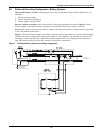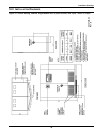
Wiring Considerations
23
7.2 Control Wiring
Control wiring must be flexible stranded, tinned copper and run in individual separate steel conduits.
Control wiring must be separated from power wiring. In addition, each control wiring cable group
should be run in a separate conduit to minimize control signal interference.
If your system has any installed options, special wire lists will be included in your Submittal Drawing
Package. Contact your Liebert Sales Representative for assistance if the submittal drawings have
been lost or misplaced.
All control cable groups are connected to different Interface Modules (IFMs) and/or terminal blocks
inside the UPS. Figures 43 and 44 show the typical location of each IFM inside the UPS. The posi-
tion of a particular IFM may be different for your UPS, depending on the model and the installed
options.
7.3 Battery Wiring
Power wiring to the battery cabinet connects positive, negative, and ground power cables from the
battery cabinet to the associated UPS. Connection of the UPS to the battery cabinet serves to both
charge and discharge the batteries (when needed). The battery disconnect (circuit breaker) requires a
control cable. Except for interconnect wiring between multiple battery cabinets, power and control
cables are field supplied. Refer to Figures 40 and 41.
Call Liebert Global Services to schedule installation check-out, final battery intercell connections and
start-up.
NOTE
The UPS control and communication wiring are considered Class 2 circuits by NEC
standards. However, NEC Class 1 wiring methods are required for these circuits to ensure
proper operation of the UPS.
!
WARNING
A battery intercell connection on each tier of the Liebert battery cabinet is disconnected for
safety during shipment. Do not complete these connections. A Liebert Global Services
representative will complete these connections as part of start-up. An improperly installed
unit can result in injury to personnel or damage to equipment.
!
CAUTION
Be sure polarity is correct when wiring the battery cabinet to the connected equipment
(positive to positive; negative to negative). If polarity is not correct, fuse failures or equipment
damage can result.
!
CAUTION
Cables between batteries and the UPS should be run in matched pairs,
positive-with-negative, within each conduit or cable run. Grouping
like-polarity cables together (i.e., positive-with-positive and
negative-with-negative) can cause stress or damage to the cables,
conduit or buswork.
NOTE
A Liebert Battery Specialist can perform a detailed inspection of the entire battery system to
ensure it meets current IEEE standards. This inspection service is recommended because
batteries are a very critical part of the UPS system.


















